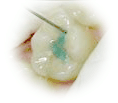 Sealants are a clear or white plastic that are placed in the grooves of the biting surfaces of back teeth.
Sealants are a clear or white plastic that are placed in the grooves of the biting surfaces of back teeth.
Back teeth have deep grooves and pits that are very difficult to keep clean. Plaque, which is a nearly invisible film of bacteria and food, collects in these grooves.
Look how the plaque shows up after it’s stained with red dye. Every time you eat, the bacteria in plaque forms acid. Without sealants, these acid attacks can cause the enamel to break down and decay. Then you have a cavity. 
To place sealants, first our Houston dentist thoroughly cleans and dries the teeth. A conditioning solution is applied, and then the sealant material is brushed into the grooves of the teeth.
Some types of sealants harden on their own, while others harden when exposed to a special light.
Sealants are an important part of a preventive dental care program.
How does a sealant help prevent decay?
A sealant is a plastic material that is usually applied to the chewing surfaces of the back teeth—premolars and molars. This plastic resin bonds into the depressions and grooves (pits and fissures) of the chewing surfaces of back teeth. The sealant acts as a barrier, protecting enamel from plaque and acids.
 Thorough brushing and flossing help remove food particles and plaque from smooth surfaces of teeth. But toothbrush bristles cannot reach all the way into the depressions and grooves to extract food and plaque. Sealants protect these vulnerable areas by “sealing out” plaque and food.
Thorough brushing and flossing help remove food particles and plaque from smooth surfaces of teeth. But toothbrush bristles cannot reach all the way into the depressions and grooves to extract food and plaque. Sealants protect these vulnerable areas by “sealing out” plaque and food.
Is sealant application a complicated procedure?
Sealants are easy for your dentist to apply, and it takes only a few minutes to seal each tooth. The teeth that will be sealed are cleaned. Then the chewing surfaces are roughened with an acid solution to help the sealant adhere to the tooth. The sealant is then ‘painted’ onto the tooth enamel, where it bonds directly to the tooth and hardens. Sometimes a special curing light is used to help the sealant harden.
As long as the sealant remains intact, the tooth surface will be protected from decay. Sealants hold up well under the force of normal chewing and usually last several years before a reapplication is needed. During your regular dental visits, your dentist will check the condition of the sealants and reapply them when necessary.
Sealants are just for kids, right?

The likelihood of developing pit and fissure decay begins early in life, so children and teenagers are obvious candidates. But adults can benefit from sealants as well.
Key ingredients in preventing tooth decay and maintaining a healthy mouth are twice-daily brushing with an ADA-accepted fluoride toothpaste; cleaning between the teeth daily with floss or interdental cleaners; eating a balanced diet and limiting snacks; and visiting your dentist regularly. Ask your dentist about whether sealants can put extra power behind your prevention program.